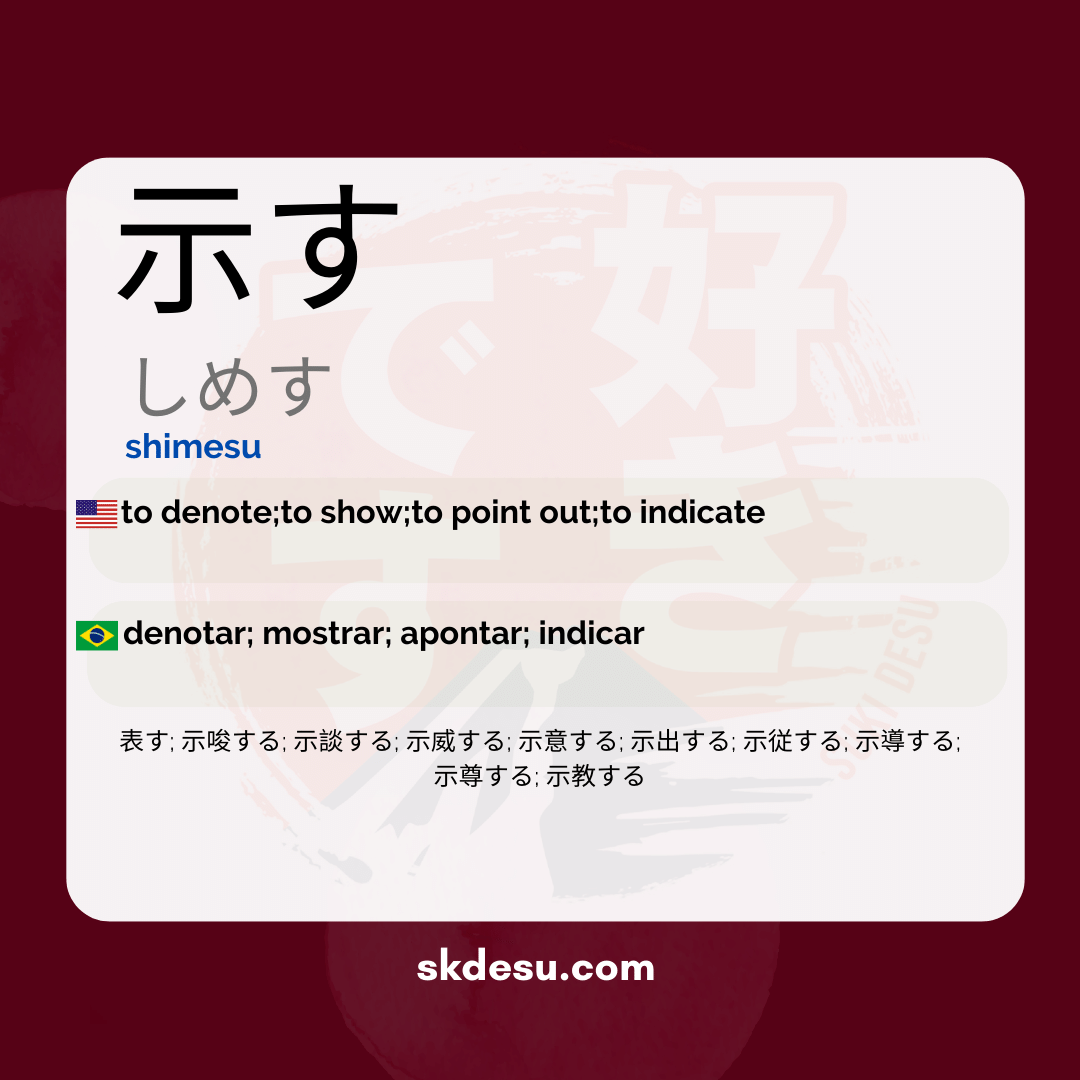Translation and Meaning of: 示す - shimesu
The Japanese word 示す [しめす] is an essential verb for anyone learning the language, as it frequently appears in everyday conversations, formal texts, and even in cultural expressions. Its main meaning is "to show," "to indicate," or "to demonstrate," but its nuances go beyond the literal translation. In this article, we will explore how this term is used in practice, its origin, and even tips for memorizing it effectively.
In addition to being a common word, 示す plays an interesting role in the Japanese language, appearing in contexts that range from simple instructions to demonstrations of feelings or evidence. If you have ever wondered how the Japanese express ideas indirectly or how certain kanjis carry deep meanings, understanding 示す can be a great starting point.
Meaning and usage of 示す in daily life
The verb 示す is often used to convey the idea of displaying something clearly, whether physically or metaphorically. For example, it can be used to show a document, indicate a path, or even demonstrate an emotion. Its versatility makes it appear in everyday dialogues, such as in "地図を示してください" (Please show the map).
An interesting characteristic is that 示す often carries a more formal or objective tone than other similar verbs, such as 見せる (to show in the sense of displaying). While 見せる can be used in more casual situations, 示す tends to appear in contexts that require clarity or authority, such as in manuals, reports, or technical explanations.
The origin and composition of the kanji 示
The kanji 示, which makes up the verb, has a curious history. Originally, it represented an altar or an offering to the gods, reflecting the idea of "showing" in the sense of revealing something sacred. Over time, its meaning expanded to encompass more general demonstrations. This connection with the divine can still be perceived in words like 暗示 (hint) or 示唆 (suggestion), which carry the notion of revealing something not obvious.
Studying the etymology of this kanji can aid in memorization, as its simplified form still retains traces of the original radical related to rituals. For those learning Japanese, noticing how 示 appears in other terms, such as 表示 (display) or 指示 (instruction), can be an effective way to expand vocabulary in a contextualized manner.
Tips for memorizing and using 示す correctly
A practical strategy to memorize 示す is to associate it with situations where clarity or proof is needed. For example, think of phrases like "証拠を示す" (to show evidence) or "結果を示す" (to demonstrate results). This pattern of usage helps internalize that the verb often appears in contexts where something needs to be made explicit or proven.
Another useful aspect is to understand how 示す differs from similar verbs. While 見せる can be used to "show a photo to friends," 示す would be more appropriate for "presenting data in a meeting." This subtle yet important distinction reflects the precision that Japanese people value in communication, especially in professional or academic settings.
Vocabulary
Expand your vocabulary with related words:
Verb conjugation of 示す
- 示す - Japanese verb
- 示して - Form Te
- 示している - Te-iru shape
- 示した - Simple past form
- 示さない - negative form
Synonyms and similar words
- 表す (arawasu) - express, represent
- 示唆する (shisa suru) - Suggest, insinuate
- 示談する (jidan suru) - Resolve by agreement, mediation
- 示威する (jiwi suru) - Hold a demonstration, protest
- 示意する (ji'i suru) - Indicate, signal
- 示出する (jishutsu suru) - Reveal, show clearly
- 示従する (shijū suru) - Show obedience, follow the instructions
- 示導する (shidō suru) - Guide, direct
- 示尊する (shison suru) - Show respect, reverence
- 示教する (shikyō suru) - Teach, give instructions
Related words
Romaji: shimesu
Kana: しめす
Type: verb
L: jlpt-n3
Translation / Meaning: denote; Show; to point; indicate
Meaning in English: to denote;to show;to point out;to indicate
Definition: Reveal something to others through words or actions.
Quick Access
- Vocabulary
- Writing
- Sentences
How to Write in Japanese - (示す) shimesu
See below a step-by-step guide on how to write the word by hand in Japanese. (示す) shimesu:
Example Sentences - (示す) shimesu
See below some example sentences:
Gogen wa kotoba no kigen wo shimesu
The etymology indicates the origin of the word.
The etymology indicates the origin of the language.
- 語源 - origin of the word
- は - Topic particle
- 言葉 - word
- の - Possession particle
- 起源 - origin
- を - direct object particle
- 示す - Indicate, show
Hitosashiyubi de sashishimesu
Point with the index finger.
Point with your index finger.
- 人 (hito) - person
- 差し指 (sashiyubi) - Index finger
- で (de) - with
- 指し示す (sashimesasu) - to point
Jouyaku wa kokka-kan no gōi o shimeshimasu.
The treaty shows an agreement between nations.
- 条約 (jōyaku) - treaty
- 国家 (kokka) - nations, countries
- 間 (kan) - between
- 合意 (gōi) - agreement
- 示します (shimeshimasu) - show, represent
Kanojo wa watashi no iken ni hankann wo shimeshita
She expressed disapproval of my opinion.
She showed my opinion in my opinion.
- 彼女 (kanojo) - she
- は (wa) - Topic particle
- 私の (watashi no) - my
- 意見 (iken) - opinion
- に (ni) - target particle
- 反感 (hankan) - aversion
- を (wo) - direct object particle
- 示した (shimeshita) - showed
Other Words of this Type: verb
See other words from our dictionary that are also: verb

